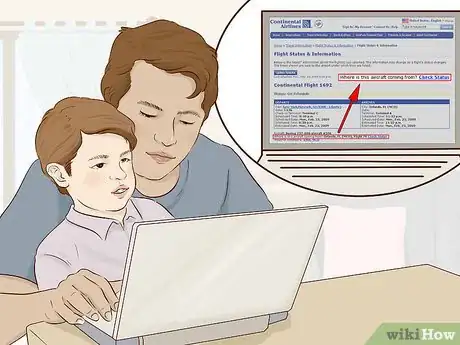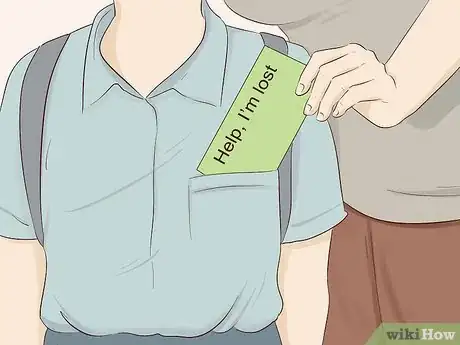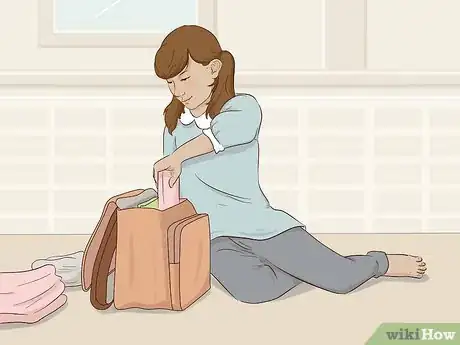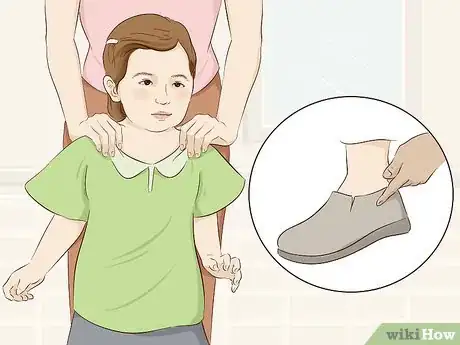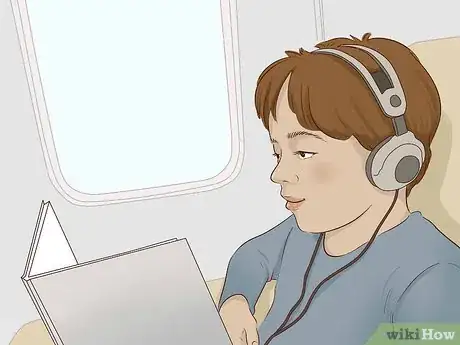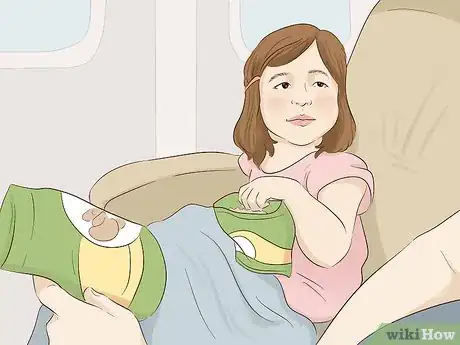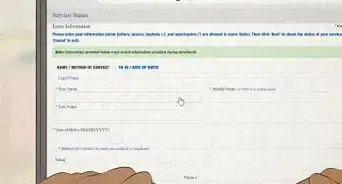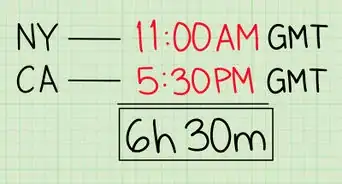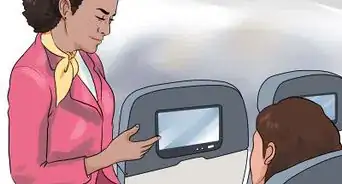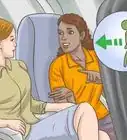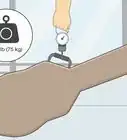This article was co-authored by Jami Yaeger. Jami Yaeger is a Parenting Specialist, Doula, and the Owner of AustinBorn, an online community offering comprehensive and modern education to growing families. With 10 years of experience, Jami specializes in whole family support for pregnancy, birth, postpartum, and parenting. Jami earned her BA in Theatre Performance from San Diego State University and earned her Certification as a Lactation Education Counselor from the University of California, San Diego. She is a Certified Infant and Child CPR Instructor, Birth and Postpartum Doula, and Childbirth Educator.
There are 9 references cited in this article, which can be found at the bottom of the page.
This article has been viewed 66,430 times.
Flying with kids doesn’t have to be difficult. There are several things you can do before, during, and after your flight to make the experience positive for your kids, yourself, and the other passengers on the plane. By thinking ahead to how the day is going to go, delegating tasks to the traveling adults, and providing good information and entertainment for your little ones, you can make your next trip with your children the best one yet!
Steps
Planning Your Adventure
-
1Choose a night or early morning flight. A sleepy kid will be more likely to conk out during the plane ride. Early morning flights also tend to be less crowded. If you’re taking an overnight flight and they just can’t calm down, try quietly reading them a bedtime story that they’ve heard before, having them listen to calming music or nature sounds, or giving them a gentle back and neck massage.
- If you’re still having trouble getting them to sleep, child doses of melatonin, Benadryl (diphenhydramine cannot be used for children under age 2), or other gentle sleep aids can help. If you are unsure about the safety of a sleep aid, ask your pediatrician for recommendations and tips.[1]
-
2Check flight costs for children as they can vary by airline. Airlines sometimes have child fare information on their website. If they don’t, call the airline and ask if you can expect a fee for an infant to sit in your lap, whether you should buy another adult seat for your toddler, and if your child needs a special safety seat based on their age and size.
- Ask the name of the representative who is helping you so that you can reference that information later if necessary.
Advertisement -
3Bring a stroller or car seat, but only if it’s absolutely necessary. Strollers and car seats can be difficult to tote around and are a hassle for connecting flights. They could also get damaged in the checked bag cargo hold. If you need a stroller, call your airline to ask about checking strollers and the related costs.[2]
-
4Check in at least two hours before your flight. There’s nothing worse than feeling stressed in the line at security because your flight is about to leave and you have little ones to get through security. Allow 2-3 hours to make it through check-in and security stress-free.
- Arriving early will also let your children explore the airport while they wait, which can make for a valuable learning experience - and is a great way to tire them out! Use a child harness if your child tends to wander.
-
5Check your flight status the night before your flight and as you arrive at the airport. If there are delays or cancellations, you’ll want to know as soon as possible so that you can make other arrangements. Take the time to explain the new plan to your little ones, since changes to a big trip can cause meltdowns.
-
6Divide up responsibilities among the adults. If you are traveling with multiple adults, set up a “buddy” system. It might be helpful to have one adult in charge of all of the paperwork while the other keeps the kids busy. Your family will know the best roles for everyone to take on.
-
7Make travel arrangements between the airport and your accommodations beforehand. Trying to bustle to a hotel when you have tired kids and no way to get there can cause unnecessary stress. Have the itinerary and maps of your destination ready for when you get off the plane. Hang on to all flight, hotel, and car reservation confirmation numbers to ease transitions.
Preparing Your Child for the Trip
-
1Put a “Help, I’m lost” card in your child’s pocket. It should have your name, address, and cell phone info on it in case they get separated from you. Keep a recent picture of your child on you. Do not let children out of your sight, and instruct them to stay close to you at all times.
-
2Walk them through the major steps of air travel like security and take-off. For example, at security, say “you might have to take off your shoes to put them through the scanner, but don’t worry, you’ll get them back! Sometimes, children under 13 can keep their shoes on while going through security, but it's good to be prepared. ”Before take-off, say "The plane is going to go really fast and shake a little, but it's okay, nothing bad will happen." Keep them involved during the scary parts by giving them a small but important job to do, such as putting item bins on the conveyor belt or turning off the electronics before take-off.[3]
-
3Let them pack their own bag. Kids will like the responsibility of preparing and carrying their own luggage. It can also help them feel more confident if they feel nervous about their adventure. Supervise packing so that everything that your child needs makes it into their bag, and don’t forget a luggage tag with your name and phone number for each bag.
-
4Dress in lightweight, comfortable clothing and slip-on shoes. Minimize the amount of metal in clothing and shoes to save time at security. Planes can be cold, so have the kids wear a jacket or keep one in their bag.
-
5Tell them that ear or tummy pain during the plane ride is only temporary. Bring earache drops and show them how to pop their ears to minimize ear pain from high altitude. If they feel nauseated, Dramamine or Emetrol can help. Consult with your doctor before using medications that your child has not used before.[4]
-
6Bring a cleanup kit for messes and accidents. Keep wet wipes, napkins, hand sanitizer, bandages, sick bags, and Pull-Ups in your carry-on. Don’t rely on the flight attendants to take care of your child’s mishaps as they have many other passengers to attend to.
Making the Journey Fun
-
1Seat your child away from the aisle. Little hands and feet can get hurt from passing passengers or the food and beverage cart, and children should not be grabbing at people or property.
-
2Make your child comfortable. It’s hard to sit still for so long, but a couple of small pillows, a blanket, and a stuffed animal can make all the difference. A comfy kid will also be less likely to want to leave their seat or kick the backs of others’ seats.
-
3Provide a variety of entertainment. Feel free to use the in-flight options, but don’t depend on them since their favorite game or show might not be available. Bring a portable game console, a phone loaded with music and audiobooks, stickers, playing cards, puzzle books, blank paper, and pencils.
- For more educational activities, have them plan a vacation using travel pamphlets or review your itinerary again. Introduce books, flashcards, and other learning materials suitable for your child’s age. If you have school-age children, ask their teacher what he or she suggests.
- Pack a small surprise gift for them, such as a new coloring book and markers crayons or colored pencils. This will help pique their interest in a new activity and fight off boredom.
-
4Bring lots of snacks. Infants only require breast milk or formula, and make sure you have bottled water if you need to mix formula on the plane. For older kids, provide low-sugar options such as cereal, puff snacks, plain pasta, sandwiches, granola bars, dried fruit, and snack pouches. Avoid items that need refrigeration, melty or crumbly foods, and bananas and avocados as they turn into brown mush in a bag.[5]
- There are rules about the amount and type of liquids or gels that can be carried past security, but exceptions are sometimes made for bottles, juice boxes and sippy-cups.[6] Make sure that you mention these items to the TSA agent before going through security and that you place them in their own quart-size zip-top bag.
-
5Reward good behavior and use consistent discipline. Compliment them on their ability to sit still, stay quiet, and respect others. Clearly define your expectations for their behavior long before your journey starts, and provide options for rewards if they behave well.[7] If they behave poorly, do not give them negative attention by yelling or spanking them, as they may see that behavior as a way to get more attention. Instead, give a firm “no” and explain why their actions were not right. Redirect their attention to a positive and engaging activity after disciplining them.[8]
-
6Stay calm. Try not to show frustration if everything doesn’t go exactly as planned. Kids can be influenced by the moods of their caregivers, and your stress can turn into their stress quickly.[9]
Expert Q&A
-
QuestionWhat should I pack in the diaper bag when flying with a baby?
 Jami YaegerJami Yaeger is a Parenting Specialist, Doula, and the Owner of AustinBorn, an online community offering comprehensive and modern education to growing families. With 10 years of experience, Jami specializes in whole family support for pregnancy, birth, postpartum, and parenting. Jami earned her BA in Theatre Performance from San Diego State University and earned her Certification as a Lactation Education Counselor from the University of California, San Diego. She is a Certified Infant and Child CPR Instructor, Birth and Postpartum Doula, and Childbirth Educator.
Jami YaegerJami Yaeger is a Parenting Specialist, Doula, and the Owner of AustinBorn, an online community offering comprehensive and modern education to growing families. With 10 years of experience, Jami specializes in whole family support for pregnancy, birth, postpartum, and parenting. Jami earned her BA in Theatre Performance from San Diego State University and earned her Certification as a Lactation Education Counselor from the University of California, San Diego. She is a Certified Infant and Child CPR Instructor, Birth and Postpartum Doula, and Childbirth Educator.
Parenting Specialist You'll want to pack extra diapers, 1 pack of wipes, hand sanitizer, diaper creams as needed, and a changing pad. Don’t overpack these things. You’ll most likely be able to stock up when you arrive at your destination. You can also purchase extras in the airport stores. As a last resort, if you run out of something, scan the airport or plane for other parents and ask them if they might have what you need.
You'll want to pack extra diapers, 1 pack of wipes, hand sanitizer, diaper creams as needed, and a changing pad. Don’t overpack these things. You’ll most likely be able to stock up when you arrive at your destination. You can also purchase extras in the airport stores. As a last resort, if you run out of something, scan the airport or plane for other parents and ask them if they might have what you need. -
QuestionWhat clothes should I pack for my baby?
 Jami YaegerJami Yaeger is a Parenting Specialist, Doula, and the Owner of AustinBorn, an online community offering comprehensive and modern education to growing families. With 10 years of experience, Jami specializes in whole family support for pregnancy, birth, postpartum, and parenting. Jami earned her BA in Theatre Performance from San Diego State University and earned her Certification as a Lactation Education Counselor from the University of California, San Diego. She is a Certified Infant and Child CPR Instructor, Birth and Postpartum Doula, and Childbirth Educator.
Jami YaegerJami Yaeger is a Parenting Specialist, Doula, and the Owner of AustinBorn, an online community offering comprehensive and modern education to growing families. With 10 years of experience, Jami specializes in whole family support for pregnancy, birth, postpartum, and parenting. Jami earned her BA in Theatre Performance from San Diego State University and earned her Certification as a Lactation Education Counselor from the University of California, San Diego. She is a Certified Infant and Child CPR Instructor, Birth and Postpartum Doula, and Childbirth Educator.
Parenting Specialist Bring extra clothes for you and baby and a wet/dry bag to hold any messes. When flying, take one extra shirt for yourself and 4 extra pieces for baby. We find footed PJs to be the best option here—baby stays warm and is less exposed. Pro tip: if you roll the clothes, they don't take up as much space in your bag.
Bring extra clothes for you and baby and a wet/dry bag to hold any messes. When flying, take one extra shirt for yourself and 4 extra pieces for baby. We find footed PJs to be the best option here—baby stays warm and is less exposed. Pro tip: if you roll the clothes, they don't take up as much space in your bag. -
QuestionHow do I keep my child healthy when flying?
 Jami YaegerJami Yaeger is a Parenting Specialist, Doula, and the Owner of AustinBorn, an online community offering comprehensive and modern education to growing families. With 10 years of experience, Jami specializes in whole family support for pregnancy, birth, postpartum, and parenting. Jami earned her BA in Theatre Performance from San Diego State University and earned her Certification as a Lactation Education Counselor from the University of California, San Diego. She is a Certified Infant and Child CPR Instructor, Birth and Postpartum Doula, and Childbirth Educator.
Jami YaegerJami Yaeger is a Parenting Specialist, Doula, and the Owner of AustinBorn, an online community offering comprehensive and modern education to growing families. With 10 years of experience, Jami specializes in whole family support for pregnancy, birth, postpartum, and parenting. Jami earned her BA in Theatre Performance from San Diego State University and earned her Certification as a Lactation Education Counselor from the University of California, San Diego. She is a Certified Infant and Child CPR Instructor, Birth and Postpartum Doula, and Childbirth Educator.
Parenting Specialist Sanitizing is key! Keep wipes handy so you can do a quick wipe down of surfaces before your child touches them. It could mean the difference between you being stuck with a sick kid in the hotel room or out enjoying a family dinner.
Sanitizing is key! Keep wipes handy so you can do a quick wipe down of surfaces before your child touches them. It could mean the difference between you being stuck with a sick kid in the hotel room or out enjoying a family dinner.
Warnings
- Make sure that children know to never mention bombs or any sort of violence in an airport as it can get the whole family in trouble.⧼thumbs_response⧽
- Have your child under the age of 3 sit in his or her own seat in an FAA-approved child safety seat, not on your lap. It's more expensive, but safer. A lap child might interfere with your ability to brace for possible impact and may not have access to an oxygen mask in the unlikely event of an emergency.⧼thumbs_response⧽
- Remember to check your airline’s website for the latest size and weight restrictions for carry-ons. Pack only the amount of juice, milk, or breast-milk that you will need for the flight in your carry-on. Larger amounts can be checked with your luggage.⧼thumbs_response⧽
- Avoid toys with small pieces. They can be easily swallowed, posing a risk to your child’s health while you’re traveling. Additionally, fetching little pieces of thrown toys from across various parts of the aircraft is impractical and embarrassing as they can land on other passengers’ faces or food.⧼thumbs_response⧽
References
- ↑ http://www.deliciousbaby.com/travel/family-travel-tips/making-travel-days-with-kids-work/air-travel-with-babies-toddlers-kids/
- ↑ https://www.tripsavvy.com/handling-strollers-during-air-travel-53936
- ↑ https://www.skyscanner.net/news/flying-children-20-top-tips-keeping-kids-happy-board
- ↑ https://consumer.healthday.com/encyclopedia/children-s-health-10/kids-ailments-health-news-434/children-and-motion-sickness-645134.html
- ↑ https://www.thekitchn.com/flying-with-kids-what-snacks-to-pack-for-the-plane-170146
- ↑ https://www.tsa.gov/travel/security-screening/liquids-rule
- ↑ https://childmind.org/article/managing-problem-behavior-at-home/
- ↑ https://www.ncbi.nlm.nih.gov/pmc/articles/PMC2719514/
- ↑ https://www.psychologytoday.com/blog/high-octane-women/201210/emotions-are-contagious-choose-your-company-wisely




